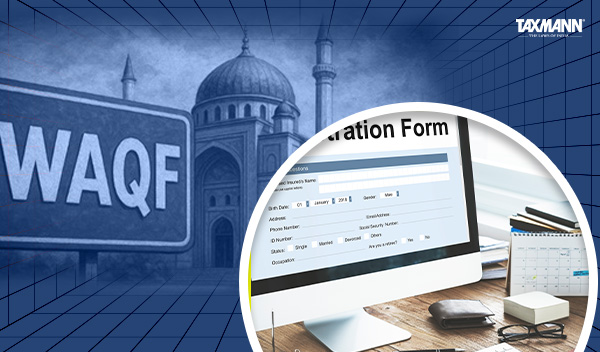
The Waqf Digital Portal, officially known as the Waqf Assets Management System of India (WAMSI), is an integrated online platform developed by the Ministry of Minority Affairs, Government of India. Launched in 2009, WAMSI aims to digitize, manage, and monitor Waqf properties across the country, enhancing transparency and efficiency in their administration .
Table of Contents
- Introduction
- From Paper to Portal – Why Digitise?
- The Collector’s New Role in Surveys
- Online Registration Requirements (Section 3B & 36)
- Mutation and Public Notice
- Enhanced Security and Verification
- Success Stories and Challenges
- Toward a Transparent Future
- Conclusion
Check out Taxmann's Unified Waqf Management Empowerment Efficiency and Development Act 1995 (UMEED) with Rules – Bare Act with Section Notes which offers a comprehensive framework for Waqf administration. It consolidates key enactments—including the Mussalman Wakf (Repeal) Act 2025—and the latest rules (e.g., Waqf Properties Lease Rules 2014, Central Waqf Council Rules 1998). A hallmark Comparative Study (old vs. new) and detailed Section Notes clarify amendments and procedures, simplifying day-to-day compliance. Aimed at legal professionals, Waqf managers, academics, officers, and policy analysts, it emphasises digital compliance, practical insights, and user-friendly referencing.
1. Introduction
A major highlight of the UMEED Act is the push for digital transformation of waqf records. Historically, incomplete or outdated manual surveys and land registries led to massive confusion. Many waqfs remained unregistered; some continue to exist only by verbal tradition, lacking legal documentation.
This article outlines how the new law addresses these challenges by introducing the Waqf Digital Portal, mandatory data uploads, and revised surveying processes—aiming to create a modern, transparent system for waqf property management.
2. From Paper to Portal – Why Digitise?
- Transparency – A centralised online database avoids hidden or duplicated records.
- Ease of Access – Researchers, potential lessees, or community members can easily verify waqf status.
- Fraud Prevention – Digitised entries reduce the ability to falsely label land as waqf.
- Accountability – Real-time data can track revenues, spending, and property usage.
3. The Collector’s New Role in Surveys
Section 4 of the UMEED Act drastically reforms the waqf survey process by transferring duties from the Survey Commissioner to the Collector (or Deputy Collector). The Collector –
- Inquires into claims of waqf property.
- Publishes an official list of recognised waqfs.
- Coordinates with the Waqf Board to ensure registration details align with revenue records.
This alignment with revenue authorities is pivotal. Since land records are often overseen by the Collector, merging waqf surveys with existing government infrastructure boosts efficiency.
4. Online Registration Requirements (Section 3B & 36)
- Existing Waqfs – Must upload their property details, mutawalli name, and waqf deed (if available) within 6 months of the Act’s commencement.
- New Waqfs – Cannot be registered without a valid deed, and must register online from the outset.
- Extensions – If a mutawalli cannot meet the 6-month deadline, an additional 6 months may be granted by the Tribunal upon showing good cause.
Failure to comply means the waqf risks losing legal recognition, as a result, courts are barred from entertaining enforcement suits if the waqf remains unregistered beyond the cutoff date.
5. Mutation and Public Notice
Under Sections 5(3) and 37(3), any property that’s to be mutated in favor of a waqf must undergo a 90-day public notice in local newspapers. Affected parties can raise objections, and the relevant land records office must hold hearings. So, only after resolving disputes can the mutation be finalised and reflected in the digital registry.
6. Enhanced Security and Verification
The waqf digital portal is envision to have verification protocols such as –
- Document Uploads – Copies of deeds, identity proofs, and encumbrance certificates.
- Unique IDs – Each waqf assigned a unique registration number, easing referencing.
- Integration with Revenue Databases – Automated checks to detect overlapping claims and if the land is marked as government property.
7. Success Stories and Challenges
- Easier Access for the Public – A student researching local waqf-funded schools can instantly check the online registry.
- Less Paperwork for Boards – Over time, digitisation reduces reliance on bulky files or missing land maps.
- Tech Literacy Hurdles – Smaller or rural waqfs may require guidance on using portals.
- Data Security Concerns – The centralise databases can be targets for cyberattacks if not adequately protected.
8. Toward a Transparent Future
Firstly, the digitisation effort aligns with broader “e-governance” initiatives in India. By ensuring waqf records are open to scrutiny and anchored in real-time government databases, the UMEED Act aims to uproot issues of dubious waqf declarations. Likewise, it also sets the stage for robust auditing and financial management.
9. Conclusion
In summation, the UMEED Act’s digital reforms hold promise for effective, transparent waqf administration. However, the synergy of Collector-led surveys and online portals can eliminate much of the chaos historically associated with waqf property records.
Dive Deeper:
Waqf Act 1995 vs. UMEED Act – Overview of Key Reforms
Definition of Waqf – How the UMEED Act Redefines Waqf Creation
Waqf Boards under UMEED Act and the Central Waqf Council
Waqf Property Ownership – New Rules on Government Land
Mutawalli Qualifications and Accountability Under the UMEED Act
The post Waqf Digital Portal – Surveys and Online Registry in UMEED Act appeared first on Taxmann Blog.

